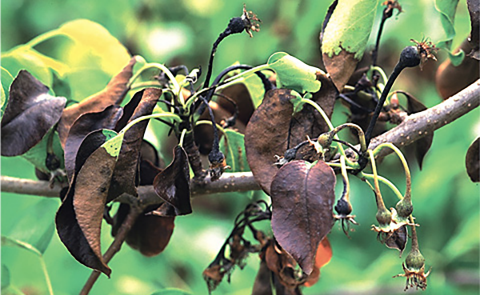Fire blight outbreaks occuring in NH

Fire blight outbreaks have been reported from several orchards around NH. The outbreaks likely occurred on unprotected blossoms during the extremely high-risk periods at the end of May, or on rat-tail blooms.
Several key points and considerations:
- Do not cut out infections during wet weather
- Cut out active infections as soon as possible (when dry)
- Pruning is most effective when incidence per tree (# of strikes) is low
- Avoid excessive pruning: it stimulates secondary growth (very susceptible)
- If incidence on a particular tree is high, it may be best to delay pruning until the dormant season (mark or flag strikes for pruning)
- Use the ‘ugly stub’ method of pruning: cut 6-12” below visible infections and leave a stub to be removed during the dormant season
- Tool sterilization is advised, but may not be very effective with very active infections (alcohol, Lysol, Oxidate, and 10% bleach can be used for sterilization)
- Consider spraying with Cueva (copper fungicide) every 7-10 days until terminal bud set. It is likely too late for effective use of Apogee (a growth regulator) this season
Dealing with fire blight infections post bloom, by Kari Peter, Fruit Pathologist with Penn State.
Read more about Fire Blight Description and Disease Cycle here.
Recent weather and the forecast for the next few days are conducive to the possibility of storm-related damage in fruiting crops. Storm damage from hail and high winds can damage plant tissue, providing an entry point for bacteria and fungi. For suggestions on control strategies in response to weather-related damage, the article below from Michigan State University provides guidance.
